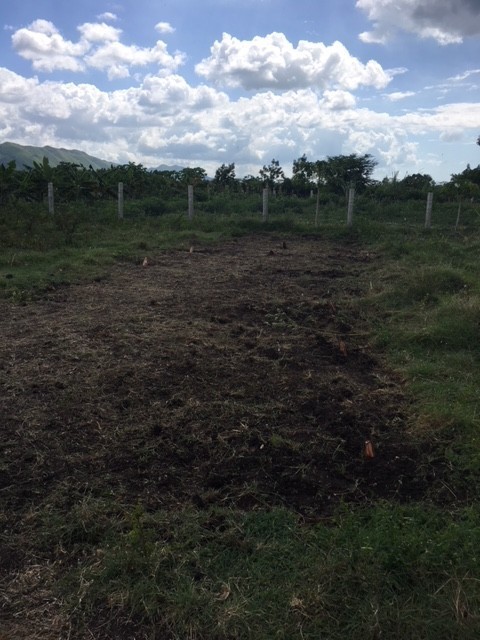Day 1 – May 29, 2018
Travel to Haiti and intro to St. Paul’s School
The Kfi Haiti Project is the Kfi Foundation’s primary service event for 2018. The objective of the project is for the Kfi team to step outside of our comfort zone and do some meaningful work for people that are a world away. People that we would not otherwise come in contact with. It is an opportunity for the team to gain a much deeper understanding of what it means to serve others. We are taking the good work that the Kfi foundation does in Colorado and applying it where the needs are different than what we encounter at home. It is also an opportunity for a few brave members of our team to grow, learn about Haiti and experience something very special.
Ian, Esteban and my 14 year old son, Max, signed on for the project. My good friend Wynn Walent, Executive Director for Colorado Haiti Project, helped plan and arrange the entire trip and traveled with us. Wynn hooked us up with another group of 5 excellent people who we traveled with and that became our good friends.
We left on a midnight flight from Denver and arrived in Haiti the next morning. After a 5 hour car ride, we arrived at St. Paul’s School in the town of Petit Trou. St. Paul’s is an agricultural school for grades K-9 and was our home for most of our trip. Once we stashed our bags in the bunk house, a group of 10 Haitian boys took us on a hike to the ocean. We were surprised that there was nobody else there because it was a beautiful spot. One of the best things about it is that in order to get into the ocean, you jump off of a rock. And then climb back up the rock when you are finished swimming. The Haitian boys and Max were immediately friends and they seemed to be able to communicate, although Max speaks no Creole and they speak no English.
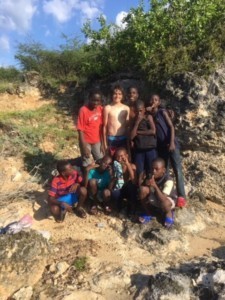
After our swim, we played smashball with the boys. Then we had a great dinner with our very hospitable host, Father Luke, who is in charge at St. Paul’s School.
Day 2 – May 30, 2018
Labor in the field
The Kfi Haiti project was carefully planned to be labor intensive and provide tangible value to the St. Paul’s community in Haiti. Our project involved clearing an overgrown field, prepping it, and then planting plantain trees. The fruit from our trees will be used by the school for food and perhaps sold to raise money for basic community needs.
We reported for duty and were issued knee-high rubber boots to keep the fire ants off of our legs, traditional Haitian straw hats to keep the sun out of our eyes and a set of hand made tools: hoes, pitch forks, pick axes and machetes.
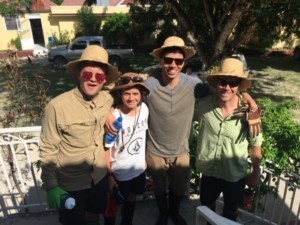
Our instructors showed us how to use the hoes and gave us some brief guidance, then set us loose. I glanced over my shoulder a minute after we started and saw them laughing really hard. They stopped us and gave us another hoeing lesson. This went on for about an hour – we are really bad at hoeing and Haitians are very good at it. There is definitely some technique involved.

Our instructors stopped finding our hoeing technique to be funny once the heads of our hoes started falling / flying off over and over again. This was due to our bad and somewhat maniacal hoeing technique. We finally (sort of) picked it up. The work was made a lot more enjoyable by frequent visitors. Word must have spread at the school that there were some ridiculous looking Americans working in the field. We had between 20-30 Haitian kids watching / laughing at us most of the afternoon.
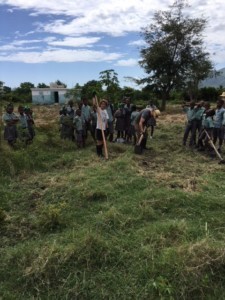
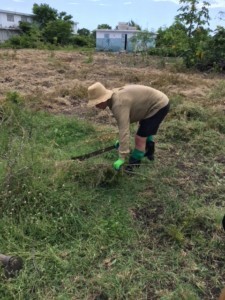
All the Haitian kids loved Max. Sometimes they completely surrounded him while he was trying to work. After 2 hours of hoeing the field, we were all pretty beat and had made little progress. We mapped out a small strip of the field that would be good for planting 14 plantain trees and determined that our goal was to get it cleared by the end of the day no matter what it took. When we finally finished clearing the strip, we dug two rows of 7 holes, in which we would plant 14 trees the next day.
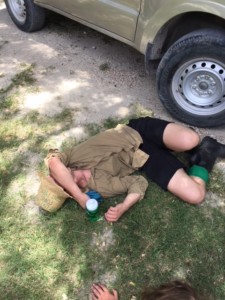
After work we swam in the ocean again, which was a fantastic reward. A big group of the kids that were watching / laughing at us in the field earlier came with us. On the hike to the ocean, the boys picked us mangos off the trees and showed us how to peel the skin off with our teeth so we could eat them. When we got back to St. Paul’s, there was a great soccer game before dinner that Max and Esteban participated in.
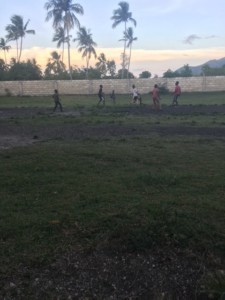
Day 3 – May 31, 2018
More work in the field
We worked hard again today. In the morning we planted 14 plantain trees on the strip of land that we cleared and then pulled weeds in the community vegetable garden and made it look tight!

After lunch we finished up our little strip of plantain field by clearing an adjacent section and planting 7 more trees for a total of 21.
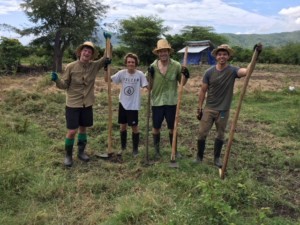
Very near to our strip, some men were « preparing » 3 goats for the harvest festival the next day. We heard the commotion with the first 2 goats, so decided to watch the 3rd. We thought we were pretty tough farmers at this point, so watching some goat prep on a water break seemed about right. The goat prep, however, was an eye opening and unpleasant experience for a couple of accountants. Much more than we bargained for. We agreed that we were not very tough farmers as we returned to the field with our tails between our legs.
On a happier note, later in the day a man gave Max and I each a coconut and cut holes in them so that we could drink the milk. That was fantastic. Then he cut the coconuts open and made us spoons and showed us how to eat the inside. After work, we went back to the ocean with a big group of boys and then there was another fantastic soccer game in the evening. The kids all know us now and greet us when they see us: Max, E, Staban and Papa Max. Those are our Haitian names. I am really attached to my new nickname and began introducing myself as Papa Max. Max earned a lot of street cred playing soccer with the Haitians so I get undeserved respect from the kids because I am Papa Max. I’ll take it.
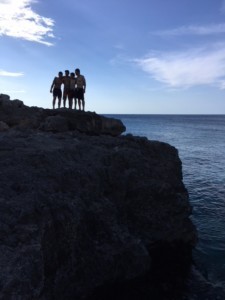
Day 4 – June 1, 2018
Harvest Festival
June 1 was the 2nd annual Harvest Festival at St. Paul’s School. The Harvest Fest is a big celebration where the school kids and local farmers sell their crops, seeds, animals and other goods. There was lots of dancing.

We taught the kids how to arm wrestle and a big tournament ensued. Everyone wanted to have a shot at Max. He must have had 50 matches against kids of all sizes.
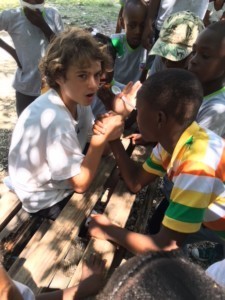
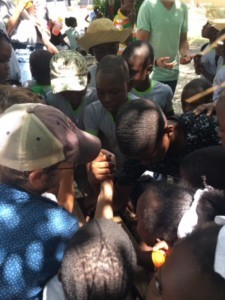
We also taught the kids how to play rock/paper/scissors. At one point we started tossing a mango back and forth and a large group gathered to play. Max carved his name in a watermelon with a bottle cap. Then a dozen of his new Haitian buddies carved their names too and then we ate the melon. Any time kids in Haiti see a new or interesting type of play, they are fascinated by it and a crowd gathers. Even though we were not doing manual labor during the Harvest Fest, we accomplished a great deal by just spending time with the kids and solidifying the friendships we had built the last few days.
After the Harvest Fest, we swam in the ocean again with a big group of Haitian boys.
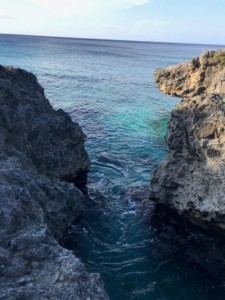
Then headed back for the last soccer match of our trip. Max plays non-stop in every game until it gets dark. Esteban jumps into games too. It is pretty cool how fired up the kids get to play soccer. Nobody owns a ball – Father Luke gets one out on special occasions such as this. Half of the kids play in bare feet and many are in sandals. So Max’s ripped up Vans do not put him at any disadvantage. A thought is taking shape in my mind to customize the soccer field at St. Paul’s and build some nice goals with nets as part of the 2019 Kfi Haiti project….
We ate all of our meals with Father Luke and his wife during our stay. They were very good to us and treated us like family. Each meal was a big event that lasted much longer than meals in the USA. There was a lot of socializing and fellowship during and after the meals. Many Haitians appear to have much deeper and meaningful relationships than Americans. Girls often hold hands while walking down the road and boys often have their arms around each other. There is lots of hugging and happiness when friends greet each other. Lots of smiling and laughing. Many of these relationships are probably built and maintained over long meals. One of my take-aways from Haiti is to try to take more time for long and meaningful meals with family, friends, co-workers and clients in order to strengthen relationships.
For our last dinner in Petit Trou, we gave Father Luke a break from serving us and drove into a nearby town for supper. There were 11 of us in the vehicle, which was about 5 too many and resulted in a flat tire early in our journey. You don’t call AAA in Haiti – there is something way better. Within 5 minutes, about 30 people and various livestock had stopped to assist us.

Random men had the truck jacked up and the tire changed way before AAA would have even arrived. They were genuinely fired up to help. How cool would it be if we started acting like that in the US? It’s a lesson I am going to try to remember when I get home – always be on the lookout for opportunities to go out of the way to help co-workers, clients, family members and strangers. Stop and help like a Haitian.
Day 5 – June 2, 2018
Decompressing at the beach
After breakfast, we left our friends at St Paul’s School and headed to a beach town called Taina a few hours away for some R&R. A group of our little Haitian buddies came to see us off. I really hope we see them all again next year at the Harvest Fest.
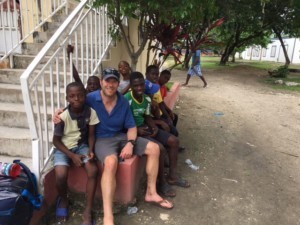
At St Paul’s, we only had electricity from 8pm – 11:30pm. Full time power was a treat at our Taina hotel! Another lesson I hope to take away from Haiti – it is a luxury to have electricity and clean water all day long. Every day. I take it for granted, but am going to try to remember to be grateful for it. Also at our hotel in Taina there were not donkeys, roosters, cows, goats and other farm animals making a racket all night long. The last few nights at St Paul’s, that was the norm. Haitian roosters don’t wait until morning to start cock-a-doodle doing in Petit Trou. They go all night.
Day 6 – June 3, 2018
The Baby House at Saint Luc’s
We left Taina after breakfast and drove to Saint Luc’s a few hours away. St. Luc’s is a giant complex / community right outside of Port au Prince that includes 2 hospitals, 2 churches, an orphanage, a tilapia farm, chicken facility, high school with 2,700 students and much more. St Luc’s was started 30 years ago by an amazing Catholic priest named Father Rick. Our day at St Luc’s was mostly spent at the Baby House, which is where many Haitian children, mostly under 6 years old, without parents or homes live. When we walked in, about 30 kids ran up to us ready to play. Piggy back rides, tickling, pummeling and laughing followed. It was a blast.
We went to 7pm mass that evening at the Catholic Church at St. Luc’s. As luck would have it, it was the Feast of Corpus Christi (or – the Feast of the Body of Christ). Father Rick gave an amazing homily about how we have the opportunity and obligation to be the body of Christ on a daily basis by helping others. Just as Christ would. It struck me that we had done just that when we played with kids at the baby house, swam with the boys at St Paul’s and gave people in Haiti some love and happiness for a few days. Christ was operating through us and we were his physical body. Father Rick also said that when we do ordinary things in extraordinary ways…this is a great way to honor God. This also struck a chord with me – we did really ordinary things the past week like farming and simply spending time with people, but did them in an awesome fashion. Honoring God. Yeah team!
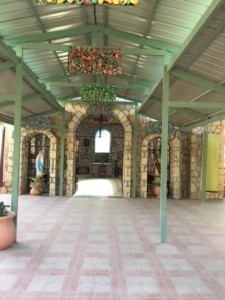
Day 7 – June 4, 2018
Travel home
We ate breakfast, played some cards and then headed back to the USA. Thank you Haiti for the amazing experience!
A huge thank you to my friend Wynn Walent from Colorado Haiti Project for planning our trip and coordinating everything we did in Haiti. Our project could not have happened without him. And if you have read this – thank you for reading!

